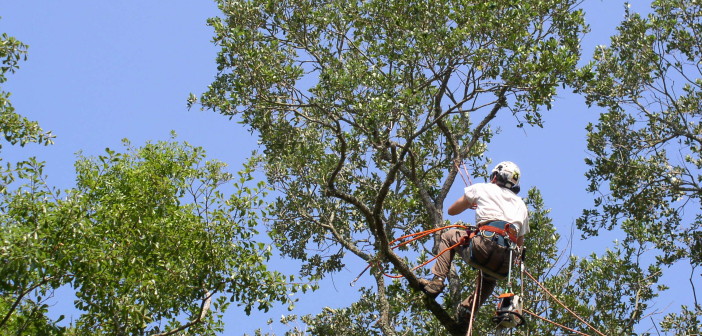Tree trimming is important for the health and appearance of a tree as well as for the safety of the people and animals that live under the tree. However, it is not a simple task, and there are risks involved that are better handled by a professional that an amateur. Even for professionals, tree trimming is a dangerous task, but they have the equipment and knowledge to greatly reduce the risk.
Accidents that involve machinery and equipment as well as electrocution are the most common dangers professionals face when they work high in a tree. A branch or limb that has been cut may hit the person in the tree on its way down to the ground. Sometimes, when certain branches are cut, the tree can snap in an unexpected direction. It is never wise to work alone when trimming a tree and co-workers must always be aware of their positions when a branch is cut.
The second most common accident is falling. Working high in a tree is dangerous for anyone, but professionals have safety lines and equipment to ensure their safety. Amateurs often have no safety ropes and use unstable ladders. Even for people who do this work every day, the weight of the power saw and other equipment they need while high in the tree can knock them off balance. Branches may look strong but be rotten inside. When a person along with equipment puts weight on this branch it will break. Professionals have the knowledge and experience to know when to trust a branch.
Branches often need to be trimmed because they are too close to utility lines. We talked with Robinson Tree Service about this topic, and they said, “Professionals know when and where to cut so as not to touch or disturb utility lines. There are qualified line-clearance tree trimmers who know the construction and operation of electric power generation, transmission and the distribution equipment involved as well as other associated hazards. They have electrician’s gloves, non-conductive clothing and hard hats with the proper rating. A do-it-yourself person runs a big risk of electrocution.”
Chain saws may look like they cut through wood like cutting through butter, but they are very dangerous for an amateur to handle. Even if the DIY person has experience with chain saws, they need protective equipment such as hearing and eye protection, chaps and fall protection. Cuts need to be well-planned in advance in order to predict where the tree branches will fall.
Along with the dangers of tree trimming, there are other considerations that a professional will be able to handle such as aesthetics and the tree’s health. Dead branches can invite disease and branches that are too close to the ground can also invite rot or insect infestation. Upper branches need to be thinned to make space for new growth. Improper trimming can create cuts that are difficult for the tree to cover with callous wood. A professional will know where and how to make cuts that actually help the tree grow and give it new life. Making the wrong cuts can allow decay to form or even kill the tree. Cuts should be made close to the branch collar without removing it.
Major trimming should be done in early spring when the tree is still dormant. The bark may be damp, which is another dangerous feature because it is slippery. Some cities have municipal laws about how large a tree can be. A local professional will know these laws and be able to keep trees within the limits.
Tree trimming is an essential part of a tree’s health and appearance, but if it is not done properly, the tree could die as well as the person trimming. According to the National Institute for Occupational Safety and Health (NIOSH), 44 percent of the people who died in the tree-care service were trimming a tree at the time. No matter how much money may be saved to DIY, it’s not worth the risk.




